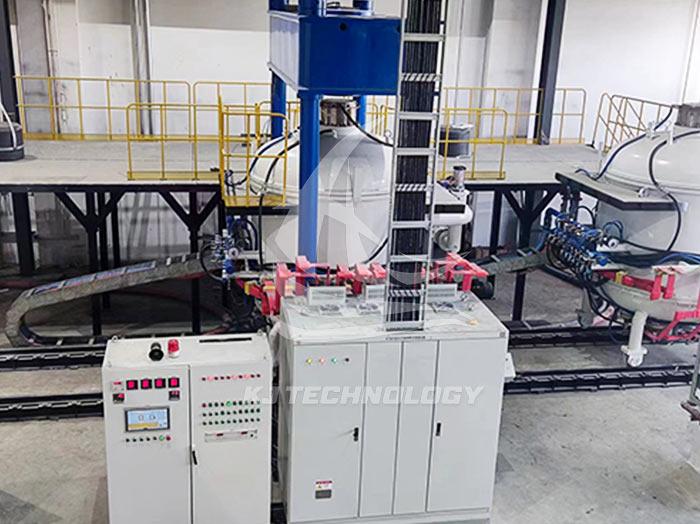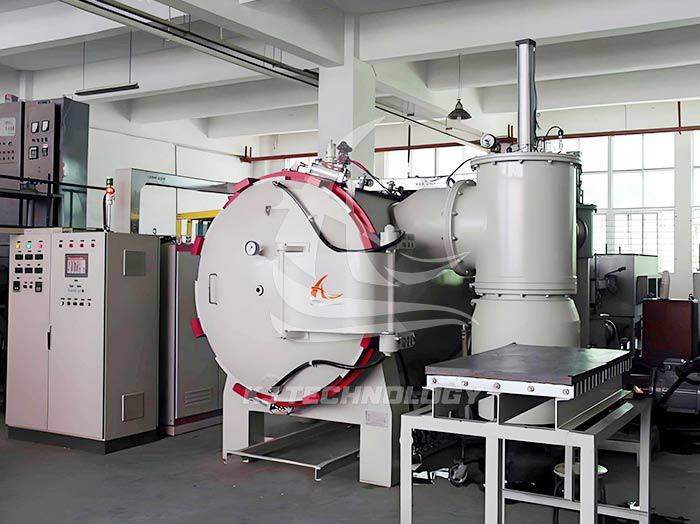What are the advantages of a vacuum atmosphere muffle furnace?
 09-12-2025 Author: KJ technology
09-12-2025 Author: KJ technology
The vacuum atmosphere muffle furnace combines vacuum environment control and atmosphere regulation functions, and has significant advantages in materials science, metallurgy, chemical engineering, and other fields. Its core advantages can be summarized as follows, and explained in conjunction with specific application scenarios:
1. Avoid oxidation and contamination, ensure sample purity
Vacuum environment isolates oxygen
Principle: The oxygen concentration in the furnace is reduced to an extremely low level (such as ≤ 10 ⁻ ³ Pa) through a vacuum pump to prevent the sample from being oxidized at high temperatures.
Application:
Metal annealing: Avoid the formation of oxide layers on metals such as iron and copper at high temperatures, and maintain surface smoothness.
Semiconductor doping: prevents oxidation of materials such as silicon wafers during high-temperature processing, ensuring doping uniformity.
MIG
Principle: Introduce inert gases such as nitrogen and argon to further isolate residual oxygen or reactive gases.
Application:
Powder metallurgy: Sintering metal powder under argon protection to prevent surface oxidation of particles and reduce bonding strength.
Heat treatment of 3D printed metal parts: Avoid the reaction of active materials such as titanium alloys with oxygen at high temperatures to maintain mechanical properties.
2. Accurately control reaction conditions and expand process possibilities
Flexibility in atmosphere regulation
Principle: Supports the introduction of multiple gases (such as H ₂, CO, CH ₄, etc.) and precise control of flow rate and proportion.
Application:
Chemical Vapor Deposition (CVD): By introducing methane and hydrogen gas at high temperatures, diamond films are deposited on the substrate surface.
Carburizing treatment: introducing hydrocarbon gas into the furnace to form a high hardness carbide layer on the surface of the steel.
The synergistic effect of vacuum and atmosphere
Principle: First, evacuate the air and then introduce the target gas to ensure a pure reaction environment.
Application:
Metal reduction: Heating iron oxide under vacuum and then introducing hydrogen gas for reduction reaction to generate high-purity iron powder.
Ceramic sintering: Sintering silicon nitride ceramics in a nitrogen atmosphere to avoid the introduction of impurities and improve material strength.
3. Improve material performance and optimize experimental results
Improve the microstructure of materials
Principle: The vacuum environment reduces the absorption of thermal radiation by gas molecules, improves temperature uniformity, and promotes uniform grain growth.
Application:
Ceramic material: Under vacuum sintering at 1600 ℃, the alumina ceramic grains are fine and uniform, and the bending strength is improved.
Metal materials: Vacuum annealing can eliminate internal stress in titanium alloys, reduce crack tendency, and increase elongation.
Reduce reaction temperature
Principle: Vacuum environment reduces gas partial pressure, allowing materials to achieve the same reaction effect at lower temperatures.
Application:
Metal melting: When vacuum induction melting iron-based alloys, the melting point is reduced by 50-100 ℃ compared to atmospheric conditions, saving energy.
Compound synthesis: Boron nitride (BN) was synthesized under vacuum, and the reaction temperature was reduced from 1800 ℃ to 1500 ℃, resulting in improved efficiency.
4. Multi functional integration to meet complex experimental requirements
Multi purpose design for one furnace
Function combination: Integrated vacuum, atmosphere control, high-temperature heating, rapid cooling and other functions to reduce equipment switching costs.
Application:
Material research and development: The same equipment can complete multiple processes such as metal annealing, ceramic sintering, CVD coating, etc.
Industrial production: realizing the entire process of raw material pretreatment, reaction synthesis, and product cooling on one production line.
intelligence control system
PID temperature control: Real time temperature feedback through thermocouples, dynamic adjustment of heating power, temperature control accuracy up to ± 1 ℃.
Program programming: supports multiple temperature rise, insulation, and cooling curve settings to adapt to different material and process requirements.
Security protection: equipped with functions such as over temperature alarm, thermocouple protection, gas leakage detection, etc., to ensure experimental safety.
5. Typical application cases
aerospace field
Titanium alloy heat treatment: heated to 700 ℃ under vacuum to eliminate processing stress and improve fatigue life, used in aircraft landing gear manufacturing.
new energy industry
Sintering of lithium battery materials: Sintering lithium iron phosphate cathode materials at 1200 ℃ in an argon atmosphere to avoid oxidation and improve battery capacity.
Semiconductor industry
Silicon wafer annealing: Annealing at 1100 ℃ in a hydrogen atmosphere to repair lattice defects and reduce resistivity, used in chip manufacturing.
Jewelcrafting
Gold purification: Heating gold containing impurities under vacuum to evaporate low boiling point impurities and improve purity.








